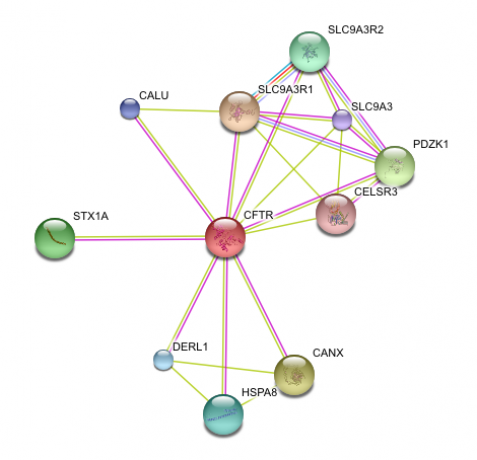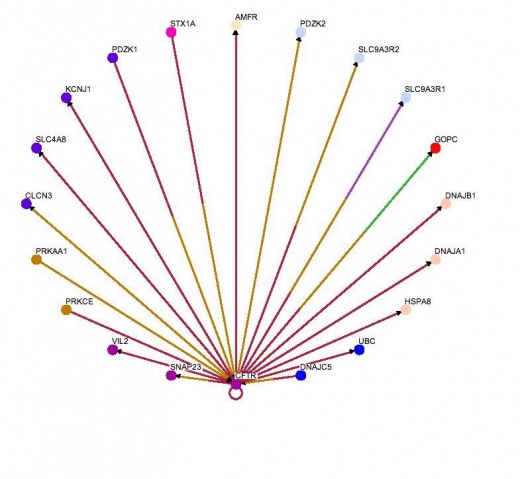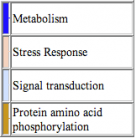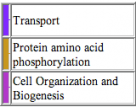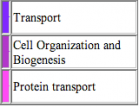This webpage was produced as an assignment for Genetics 677, an undergraduate course at the University of Wisconsin - Madison.
STRING
STRING is a database of known and predicted protein interactions. The interactions include direct (physical) and indirect (functional) associations; they are derived from four sources: genomic context, high-throughput experiments, coexpression, and previous knowledge. STRING quantitatively integrates interaction data from these sources for a large number of organisms, and transfers information between these organisms where applicable. The database currently covers 2,590,259 proteins from 630 organisms. (1)
Below is the evidence view of the protein interaction network of CFTR generated by STRING.
Below is the evidence view of the protein interaction network of CFTR generated by STRING.
CFTR: Cystic fibrosis transmembrane conductance regulator (CFTR) (cAMP- dependent chloride channel) (ATP-binding cassette transporter sub- family C member 7); Involved in the transport of chloride ions.
STRING predicted CFTR functional partners:
SLC9A3R2: Na(+)/H(+) exchange regulatory cofactor NHE-RF2 (NHERF-2) (Tyrosine kinase activator protein 1)
SLC9A3R1: Ezrin-radixin-moesin-binding phosphoprotein 50 (EBP50) (Na(+)/H(+) exchange regulatory cofactor
CANX: Calnexin precursor (Major histocompatibility complex class I antigen-binding protein)
PDZK1: PDZ domain-containing protein 1 (Na/Pi cotransporter)
STX1A: Syntaxin-1A (Neuron-specific antigen HPC-1)
HSPA8: Heat shock 70 kDa protein 8; Chaperone.
DERL1: Derlin-1 (Degradation in endoplasmic reticulum protein) (Der1-like protein 1)
CALU: Calumenin precursor (Crocalbin) (IEF SSP 9302)
SLC9A3: Sodium/hydrogen exchanger 3 (Na(+)/H(+) exchanger 3) (NHE-3) (Solute carrier family 9 member 3)
CELSR3: SH3 adapter protein SPIN90 (NCK-interacting protein with SH3 domain)
STRING predicted CFTR functional partners:
SLC9A3R2: Na(+)/H(+) exchange regulatory cofactor NHE-RF2 (NHERF-2) (Tyrosine kinase activator protein 1)
SLC9A3R1: Ezrin-radixin-moesin-binding phosphoprotein 50 (EBP50) (Na(+)/H(+) exchange regulatory cofactor
CANX: Calnexin precursor (Major histocompatibility complex class I antigen-binding protein)
PDZK1: PDZ domain-containing protein 1 (Na/Pi cotransporter)
STX1A: Syntaxin-1A (Neuron-specific antigen HPC-1)
HSPA8: Heat shock 70 kDa protein 8; Chaperone.
DERL1: Derlin-1 (Degradation in endoplasmic reticulum protein) (Der1-like protein 1)
CALU: Calumenin precursor (Crocalbin) (IEF SSP 9302)
SLC9A3: Sodium/hydrogen exchanger 3 (Na(+)/H(+) exchanger 3) (NHE-3) (Solute carrier family 9 member 3)
CELSR3: SH3 adapter protein SPIN90 (NCK-interacting protein with SH3 domain)
OSPREY
The Osprey Network Visualization System is a tool for visualization and manipulation of complex interaction networks. Osprey builds data-rich graphical representations that are color-coded for gene function and experimental interaction data. (2)
Below is a beautiful protein interaction network created by OSPREY, centered around CFTR. (The loop on the bottom indicates that CFTR interacts with itself.)
Below is a beautiful protein interaction network created by OSPREY, centered around CFTR. (The loop on the bottom indicates that CFTR interacts with itself.)
CFTR
cystic fibrosis transmembrane conductance regulator (ATP-binding cassette sub-family C, member 7); ATP-binding cassette sub-family C, member 7|cystic fibrosis transmembrane conductance regulator.
GO Components:
- lipid raft
- mitochondrion
- focal adhesion
- cytosol
- integral to membrane
- flagellum
- membrane
- caveolar membrane
- integral to plasma membrane
- plasma membrane
- cytoplasmic vesicle membrane
- soluble fraction- membrane fraction
- basal plasma membrane
- apical plasma membrane
- basolateral plasma membrane
cystic fibrosis transmembrane conductance regulator (ATP-binding cassette sub-family C, member 7); ATP-binding cassette sub-family C, member 7|cystic fibrosis transmembrane conductance regulator.
GO Components:
- lipid raft
- mitochondrion
- focal adhesion
- cytosol
- integral to membrane
- flagellum
- membrane
- caveolar membrane
- integral to plasma membrane
- plasma membrane
- cytoplasmic vesicle membrane
- soluble fraction- membrane fraction
- basal plasma membrane
- apical plasma membrane
- basolateral plasma membrane
Analysis
STRING is the most frequently used protein interaction network database, and sorts relevant proteins by their hit scores, while OSPREY's data network narrows down by the most meaningful interaction protein via the most significant and related experimental processes and GO terms.
CFTR has many proteins which interact with it, CFTR even interacts with itself. After looking at the function of some of these interacting proteins, it is clear that many of them are involved in protein binding, indicating that there may be some complex formations with CFTR. It is known that SLC9A3R1 forms a complex with CFTR.
CFTR has many proteins which interact with it, CFTR even interacts with itself. After looking at the function of some of these interacting proteins, it is clear that many of them are involved in protein binding, indicating that there may be some complex formations with CFTR. It is known that SLC9A3R1 forms a complex with CFTR.
_______________
References
1. STRING. Accessed March 22, 2010. http://string-db.org/
2. OSPREY. Accessed April 11, 2010. http://en.bio-soft.net/protein/Osprey.html
References
1. STRING. Accessed March 22, 2010. http://string-db.org/
2. OSPREY. Accessed April 11, 2010. http://en.bio-soft.net/protein/Osprey.html
Alexandra Reynolds
[email protected]
